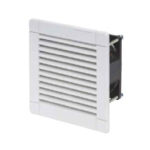NEMA Electrical Enclosures Simplified - Trimantec
Table of Contents:
What Are Electrical Enclosures?
Electrical Enclosures Sizes and Weights
Benefits of NEMA-Rated Enclosures?
Steel Enclosures vs. Non-Metallic Enclosures
Add Enclosure Accessories to Complete the Look
Let’s talk about boxes. But not just ordinary boxes. In this blog, we explore the many options available when shopping for electrical enclosures. These industrial boxes house sensitive electrical components. So, determining the correct level of protection is very important. We’ll cover the most popular NEMA ratings associated with enclosures, as well as materials and accessories.
What Are Electrical Enclosures?
Electrical enclosures, also known as control panel enclosures or simply enclosures, are specially designed cabinets that hold industrial components. There are two main purposes for these cabinets. They protect engineers and technicians from electric shock and protect the components inside from their surrounding environment. They come in all shapes and sizes to accommodate any situation.
Electrical Enclosure Sizes and Weight
Choosing a size is as simple as planning out the components that will reside within the enclosure. If you know that you’ll eventually add more components, take this into consideration as well. Also, consider the overall weight of the enclosure and the components. If the total number of components comes to a hefty weight, then considering a lighter material for the enclosure may not be a bad idea. This is especially important if the enclosure will be wall-mounted or pole-mounted.
When shopping for enclosures, you’ll most likely run into the acronym NEMA. This stands for the National Electrical Manufacturers Association which sets the standards for electrical enclosures. Individual electrical enclosure manufacturers follow these standards so their products meet the required performance criteria. How do you know which NEMA rating you need? Below is a list of the most popular NEMA ratings along with their performance attributes and best-suited applications.
NEMA 1 Rating – For indoor commercial applications. Requires the least amount of protection.
NEMA 3R Rating – Commonly used for meter cabinets or utility boxes. For indoor or outdoor use. One very important advantage is they can withstand elements such as rain, snow, and windblown particles.
NEMA 4 Rating – Used in industrial applications such as wiring enclosures, hydraulic controls, and operator consoles. These enclosures are watertight which helps protect components from all types of weather conditions.
NEMA 4X Rating – Nema 4x enclosures have the same features as NEMA type 4 but also provide additional protection against corrosion. They are typically found in marine environments; industrial food processing; water treatment; oil and gas drilling, refining and processing; and paper manufacturing applications.
NEMA 12 – These types of enclosures are dust-tight for indoor use. Not to be confused with the water-tight features of the type 4 standard. This standard is not suitable for washdown environments.
Benefits of NEMA-Rated Enclosures
As you've learned, each NEMA enclosure is different according to their performance and application. Some are applied inside commercial settings while others are used outdoors in industrial settings. Although variations exist within each NEMA enclosure, they all essentially protect against human injuries and prevent early component failure. NEMA enclosures can protect electrical components from:
- Human contact: Eliminates electrical shock and protects against human contact.
- Water: Protects electrical components from light and hazardous water exposure.
- Environmental impacts: Protects against debris and extreme cold climates.
- Explosions: Shields against possible explosions using NEMA 7-10.
So which NEMA enclosure should you choose? Each NEMA is different and unique. Choosing the right NEMA depends on your component's type of application and location. In the long run choosing the right NEMA will save you money and protect others from potential injuries.
Steel Enclosures vs. Non-Metallic Enclosures
The material of an enclosure can determine its durability and flexibility in terms of on-site modifications. A few factors to consider when choosing the material include environmental conditions, budget, and overall weight. Then, of course, there is the aesthetic appeal of certain materials.
Metallic materials include mild steel and stainless steel. The main difference between the two is that stainless steel is corrosion-resistant while mild steel is not. Also, stainless steel is shinier…If you’re budget-conscious though, opt for mild steel enclosures.
If you’re looking for a material that is both durable and easily modified at the job-site, your best bet is to go with non-metallic enclosures. These include enclosures made from fiberglass, polycarbonate, and polyester materials. They are also a lighter alternative to their steel counterparts.
Below is a handy chart that details how each material performs under certain conditions. This chart is courtesy of Hoffman.
Add Enclosure Accessories to Complete the Look
There are several enclosure accessories that add functionality and convenience to any enclosure. To mount components within the enclosure, add a sub panel and DIN rails to your cart. Purchasing a fan can help keep components cool, consequently increasing their lifespan. Additionally, panel heaters and thermostats can help regulate optimum temperatures within the enclosure. There is also a variety of locking and latching mechanisms for added security and safety. With all these options available, assembling the perfect enclosure is easily attainable.
All in all, choosing an enclosure can be achieved by answering three simple questions.
- How big does it need to be?
- What environment will it reside in?
- What is the total weight of the components?
Answering these questions will help guide you in choosing an enclosure with the correct specifications. At Trimantec, we are proud to offer you a wide selection of Saginaw, Fibox and Tecnomatic enclosures available in all shapes and sizes. We carry enclosures with NEMA ratings of 1, 3R, 4, and 12. Still not completely comfortable with picking out an enclosure? No worries, our team is here to answer any questions you may have!



